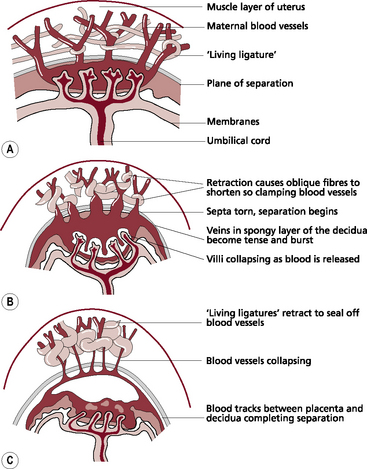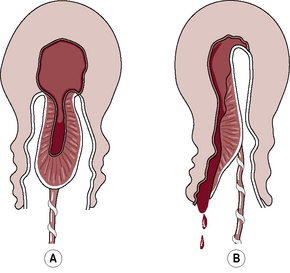Chapter 19 The Third Stage of Labour
Physiological processes
Separation and descent of the placenta
Mechanical factors (Fig. 19.1)
Separation usually begins centrally so that a retroplacental clot is formed (Fig. 19.2). Two methods of separation are described:
Haemostasis
The three factors that are critical to control of bleeding are the following:
 Retraction of the oblique uterine muscle fibres in the upper uterine segment through which the tortuous blood vessels intertwine.
Retraction of the oblique uterine muscle fibres in the upper uterine segment through which the tortuous blood vessels intertwine.
 The presence of vigorous uterine contraction following separation – this brings the walls into apposition so that further pressure is exerted on the placental site.
The presence of vigorous uterine contraction following separation – this brings the walls into apposition so that further pressure is exerted on the placental site.
 The achievement of haemostasis – following separation, the placental site is rapidly covered by a fibrin mesh utilising 5–10% of the circulating fibrinogen.
The achievement of haemostasis – following separation, the placental site is rapidly covered by a fibrin mesh utilising 5–10% of the circulating fibrinogen.
Management of the third stage
Uterotonics or uterotonic agents
Expectant or physiological management
In the event of expectant management:
 routine administration of the uterotonic drug is withheld
routine administration of the uterotonic drug is withheld
 the umbilical cord is left unclamped until cord pulsation has ceased or the mother requests it to be clamped, or both
the umbilical cord is left unclamped until cord pulsation has ceased or the mother requests it to be clamped, or both
 the placenta is expelled by use of gravity and maternal effort.
the placenta is expelled by use of gravity and maternal effort.
Active management
Combined ergometrine and oxytocin
(A commonly used brand is Syntometrine.)
 A 1-ml ampoule contains 5 IU of oxytocin and 0.5 mg ergometrine and is administered by intramuscular injection.
A 1-ml ampoule contains 5 IU of oxytocin and 0.5 mg ergometrine and is administered by intramuscular injection.
 The oxytocin acts within 2.5 minutes, and the ergometrine within 6–7 minutes.
The oxytocin acts within 2.5 minutes, and the ergometrine within 6–7 minutes.
 Their combined action results in a rapid uterine contraction enhanced by a stronger, more sustained contraction lasting several hours.
Their combined action results in a rapid uterine contraction enhanced by a stronger, more sustained contraction lasting several hours.
 Administered, normally, at birth of the anterior shoulder.
Administered, normally, at birth of the anterior shoulder.
 Caution. No more than two doses of ergometrine 0.5 mg should be given, as it can cause headache, nausea and an increase in blood pressure; it is normally contraindicated where there is a history of hypertensive or cardiac disease.
Caution. No more than two doses of ergometrine 0.5 mg should be given, as it can cause headache, nausea and an increase in blood pressure; it is normally contraindicated where there is a history of hypertensive or cardiac disease.
< div class='tao-gold-member'>
Stay updated, free articles. Join our Telegram channel

Full access? Get Clinical Tree














